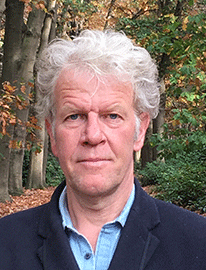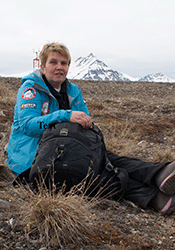Evolutionary ecology

I am an integrative behavioural and evolutionary ecologist studying the evolution of social behaviour and life history patterns in social animals, with the goal of discovering why and how animals cooperate or compete with each other. My research focuses on behaviour as this is the level at which organisms interact most directly with their physical and social environment. I integrate empirical and theoretical studies to obtain deeper knowledge of the evolution of adaptive behavioural responses. I focus on long-term studies of wild birds in naturally varying environments; these are complemented with experimental studies at the individual and local population levels. Starting in 1985, I established one of the best known model systems in evolutionary ecology: the Seychelles warbler. Warblers normally produce one chick per nest and can be cooperative breeders, in which more than two individuals are engaged in raising the single offspring. My research focuses on two groups of questions:
(i) What drives the evolution of group living and cooperative breeding?
Offspring often delay dispersal and remain in their natal territory. My work provided confirmation of two much-debated hypotheses on the ecological factors influencing delayed dispersal. I discovered that the main cause of such delay is the degree of habitat saturation. However, the amount of insect prey available in a territory is also an important factor. For a young bird, the breeding success and survival benefits of remaining and helping in good territories (high food abundance) outweigh the benefits of independent breeding in poor areas, and offspring from good territories rarely disperse to breed in poor areas. We found that most helpers are females, usually daughters from previous broods, and that it is the males who typical disperse from their natal territory. Helpers increase their fitness indirectly by preferentially feeding more closely related offspring, and directly through gaining breeding experience and parentage within their own group. For breeding pairs living in high-quality territories, having helpers increases their reproductive success and survival, but in low-quality territories helpers compete with breeders for food resources.
(ii) What drives the evolution of sex allocation?
I showed that mothers in high-quality territories produce mainly daughters (the helping sex), while in low-quality territories they produce mainly sons (the dispersing sex). This skew in the sex ratio is striking, because birds were thought to be unable to skew sex ratios (their sex is determined by chromosomes). By producing more daughters in high-quality territories, mothers gain future helpers, lightening their own provision load, increasing total feed to nestlings, and improving their survival, reproductive success, and longevity. In contrast, mothers in low-quality territories produce dispersing offspring and so avoid competition over food resources that would lower reproductive success. In addition, daughters born in high-quality territories have higher survival and reproductive success than sons, while the reverse is true for low-quality territories. My research has stimulated wider interest in how vertebrates manipulate offspring sex ratios.
As food availability and its spatio-temporal variation have changed, so the selection pressures on individuals have, and have forced them to adopt other strategies. We now need to investigate how unpredictable environmental changes affect how animals cooperate or compete with one another, and the implications of environmentally induced sociality on per capita and long-term fitness.
I publish regularly in the fields of evolutionary biology, behavioural biology, zoology, ecology, and genetics, but also in theoretical biology, biodiversity conservation, environmental sciences, immunology and endocrinology, and occasionally in psychology, molecular biology and medical science. Starting January 2020, I am a member of the Editorial Board of the journal Behavioral Ecology.
External collaborations

Isabella Scheiber
(University of Vienna, Austria)
My main interest as a behavioural physiologist is to investigate the underlying mechanisms of complex avian sociality in captive, semi-tame, and wild geese [1]. I have worked intensively on the severe consequences that social stress can cause to an individual’s wellbeing, and the fact that a proper social embedding may help individuals to cope with this stress (‘social support’), using greylag geese (Anser anser) as a model system. After moving to the Komdeur lab as a postdoc in 2012, we had the unique opportunity to expand these studies on barnacle geese (Branta leucopsis) on Spitsbergen in the high Arctic. We examined the influence of trace contaminants on the behaviour and physiological processes of young barnacle geese in acute stress situations, as it is well known that natural populations are exceedingly exposed to contamination from human sources. The study was performed in and around Ny-Ålesund (Spitsbergen, 78°55'N, 11°56'E), where a coal mine imploded more than 50 years ago. While the areas in and around the village were remediated after the implosion, the area around the abandoned mine was left in a contaminated state. A complementary study showed that both soil and vegetation in the abandoned mine still show higher levels of trace metals, and that these trace metals can accumulate in the body of the geese [2]. We compared goslings, which fed either in the contaminated mine or in clean areas during the first days of life. We subsequently exposed these goslings to established stress tests and recorded their behaviour as well as stress hormone levels. In these tests, the goslings were isolated from their family members for a short time or were restricted in their movement, which causes a stress response in highly social animals such as geese. Contaminant-exposed goslings behaved consistently more restless and showed a greater increase in stress hormone levels than their non-exposed siblings during these tests. The results indicate that exposed goslings actually perceived these tests as more stressful, and overall the reactions of the exposed goslings were less predictable [3, 4]. Baseline immunological parameters, however, were not affected [5]. In a second study we also described the excretion patterns of stress hormones of barnacle goslings under 24 hours of continuous natural light in the Arctic. In lower latitudes, circulating corticosterone peaks around waking and shows a nadir between midnight and 4:00. Photoperiod, along with other environmental factors, helps to entrain an animal's endogenous rhythm to that of the natural world. North of the Arctic Circle, photoperiod may not be a reliable cue as light is continuously absent during winter and continuously present during summer. We showed that juvenile barnacle goslings have a circadian pattern of corticosterone (CORT) in their droppings under 24h of natural daylight, which deviated from the CORT patterns of barnacle geese at lower latitudes by peaking in the evening rather than the morning hours [6].
Based on these findings I was granted financial support by the Austrian Science Fund (FWF P 32216-B) to examine, for the first time, how three hormones (corticosterone, melatonin and prolactin) behave under polar summer light conditions in individual geese, and if and how they are associated with activity. Another unique part in this project is that we will continue data collection by tracking those geese throughout the year using GPS transmitters to assess seasonal adaptations and relationships of the three hormones and biologically relevant events, such as migration and overwintering. Based at the University of Vienna, I, together with Margje de Jong, will collaborate with the Arctic Centre of the University of Groningen and the lab of Prof. Komdeur. As a control group, we will use J. Komdeur’s captive barnacle geese to investigate the same relationships that we study in the wild Arctic geese, but under temperate zone photoperiodic conditions. This new study is fascinating as it shows the effects of time and rhythmical phenomena of life processes.
A second line of research that I am interested in is to understand the alterations in brain size with an alleged impact on cognitive abilities in species along the altricial-precocial spectrum. The altricial-precocial spectrum describes the degree of behavioural and morphological maturation of offspring at the moment of birth or hatching. It is now well established that these different developmental trajectories have long-term consequences in various aspects of endocrine, reproductive or other physiological mechanisms. There are recent claims that the manner and quality of social relationships depend on the developmental mode due to the link of developmental mode and brain development. We performed a thorough review of the existing literature and showed that many mammal and bird species are skilled in a wide range of contexts in the social domain and the existence of these social skills in both altricial and precocial species suggests that social skills are generally irrespective of species’ developmental trajectories [7].
- Scheiber IBR, Sterenborg M, Komdeur J (2015). Stress assessment in captive greylag geese (Anser anser). J. Anim. Sci. 93: 2124-2133, doi: 10.2527/jas.2014-8523
- van den Brink NW, Scheiber IBR, de Jong ME, Braun A, Arini A, Basu N, van den Berg H, Komdeur J Loonen MJJE (2018). Mercury associated neurochemical response in Arctic barnacle goslings (Branta leucopsis). Sci. Total Environ. 624: 1052-1058, doi: 10.1016/j.scitotenv.2017.12.191
- Scheiber IBR, Weiß BM, de Jong ME, Braun A, van den Brink NW, Loonen MJJE, Millesi E, Komdeur J (2018). Stress behaviour and physiology of developing Arctic barnacle goslings (Branta leucopsis) is affected by legacy trace contaminants. P. Roy. Soc. B - Biol. Sci. 285: 20181866, doi: 10.1098/rspb.2018.1866
- Komdeur J, Weiß B, Scheiber IBR (2016). Bygones aren't bygones. Pan European Networks: Science and Technology 19: 240-241 [view online]
- de Jong ME, Scheiber IBR, van den Brink NW, Braun A, Matson KD, Komdeur J, Loonen MJJE (2017). Indices of stress and immune function in Arctic barnacle goslings (Branta leucopsis) were impacted by social isolation but not a contaminated grazing environment. Sci. Total Environ. 601-602: 132-141, doi: 10.1016/j.scitotenv.2017.05.183
- Scheiber IBR, de Jong ME, Komdeur J, Pschernig E, Loonen MJJE, Millesi E, Weiß BM (2017) Diel pattern of corticosterone metabolites in Arctic barnacle goslings (Branta leucopsis) under continuous natural light. PLOS One 12: e0182861, doi: 10.1371/journal.pone.0182861
- Scheiber IBR, Weiß BM, Kingma SA, Komdeur J (2017) The importance of the altricial - precocial spectrum for social complexity in mammals and birds - A review. Front. Zool. 14:3: 3, doi: 10.1186/s12983-016-0185-6
| Last modified: | 06 October 2023 7.04 p.m. |
